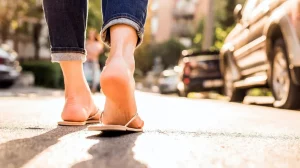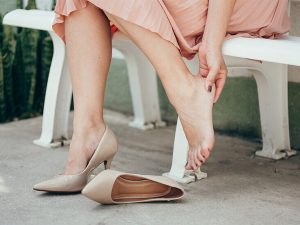Cracked heels aren’t just a cosmetic concern—they can be painful and even lead to more serious foot problems if left untreated. The dryness, rough texture, and occasional bleeding can make everyday activities uncomfortable. But did you know that the sandals you wear can play a pivotal role in both causing and soothing this issue?
The right pair of sandals doesn’t just protect your feet; they can actively support healing and prevent further damage. By choosing footwear designed for comfort and foot health, you can walk confidently without the worry of worsening your cracked heels.
In this guide, we’ll explore the best sandals for cracked heels that combine style, functionality, and therapeutic benefits. Whether you’re looking for all-day support or something chic for casual outings, we’ve got you covered.
Also Read: Best Shoes For Metatarsalgia
Best Sandals For Cracked Heels
Why Cracked Heels Need Special Sandals
Cracked heels are more than a sign of dry skin—they’re often a result of the stress and pressure your feet endure daily. When the skin around your heels becomes dry and loses elasticity, the constant pressure from standing, walking, or improper footwear causes it to crack. Factors like harsh weather, prolonged standing, obesity, and wearing open-back or unsupportive shoes can worsen the problem.
Specialized sandals are designed to address these issues, offering more than just comfort. Unlike standard sandals, they provide targeted support that helps distribute pressure evenly across your feet, reducing strain on the heel area. Features like cushioned insoles and ergonomic designs cradle your feet, minimizing the risk of further damage.
These sandals often include moisture-retaining materials that help combat dryness, a key contributor to cracked heels. Many also feature a closed or semi-closed heel design to protect vulnerable areas while still allowing your feet to breathe. For those prone to foot fatigue, shock-absorbing soles can be a game-changer, reducing the impact on your heels with every step.
Investing in the right sandals isn’t just about comfort; it’s about giving your feet the care they deserve. Whether you’re running errands, lounging at home, or heading out for a casual stroll, choosing the right footwear can actively support the healing process and prevent painful cracks from returning.
Best Sandals For Cracked Heels | Comparison Table 2025
Best Sandals For Cracked Heels | Reviews 2025
1.Vionic Women’s Tide II Toe Post Sandals For Cracked Heels
When it comes to choosing footwear that blends comfort, style, and functionality, the Vionic Women’s Tide II Toe Post Sandal stands out. Designed with thoughtful features, this sandal is a game-changer for individuals dealing with cracked heels.
Comfort and Cushioning
The Vionic Tide II offers exceptional cushioning, thanks to its podiatrist-designed footbed. Its contoured sole provides ample support, reducing pressure on the heels and encouraging natural alignment, which is essential for those with cracked heels.
Arch Support
One of the standout features of this sandal is its built-in arch support. Whether you have high arches or flat feet, this feature ensures your feet stay comfortable throughout the day while promoting healing for cracked skin.
Heel Coverage and Breathability
While it’s an open-toe sandal, the Vionic Tide II strategically supports the heel by elevating it slightly, minimizing friction and pressure that often exacerbate cracked heels. The breathable material ensures your feet stay cool and dry, preventing further skin issues.
Material Quality and Slip-Resistance
Crafted from high-quality materials, these sandals are durable yet lightweight. The textured outsole offers excellent slip resistance, making them suitable for a variety of surfaces, from sandy beaches to tiled floors.
Adjustability and Shock Absorption
The adjustable straps ensure a snug fit, catering to different foot shapes. Additionally, the sandal features EVA midsole technology for shock absorption, reducing stress on the heels and other pressure points.
Ease of Cleaning and Style
Cleaning the Vionic Tide II is a breeze, thanks to its water-resistant construction. On the style front, it strikes the perfect balance between casual and chic, available in multiple colors to complement any wardrobe.
Durability and Price
Designed to last, these sandals offer excellent value for money. They may come at a slightly higher price point, but their longevity and therapeutic benefits justify the investment.
User Reviews and Feedback
Many users rave about the instant comfort and relief these sandals provide. They’re highly recommended for those with plantar fasciitis or cracked heels, with reviews frequently highlighting their effectiveness and style.
Size and Orthopedic Features
The Vionic Tide II is available in various sizes and widths, ensuring an optimal fit for most users. Its orthopedic features, such as biomechanical footbed design, make it a top choice for foot health enthusiasts.
- Exceptional cushioning supports cracked heels and relieves pressure.
- Built-in arch support promotes natural foot alignment.
- Durable, lightweight materials with excellent slip resistance.
- Adjustable straps ensure a custom fit for all foot shapes.
- Biomechanical footbed aids in healing and prevents discomfort.
- Slightly higher price compared to standard sandals.
- Limited heel coverage may not suit severe heel cracks.
2.
3.
4.
5.
6.
7.
8.
9.
How To Choose The Best Sandals For Cracked Heels | Unrivaled Guide 2025
Finding the perfect sandals for cracked heels isn’t just about aesthetics; it’s about ensuring your feet get the care and support they deserve. The wrong pair can worsen discomfort, while the right one can help protect and heal your heels. By considering your lifestyle, foot shape, and the severity of your cracked heels, you can confidently select footwear that prioritizes your comfort and health.
1. Consider Your Lifestyle
Your daily activities play a big role in determining the type of sandals you need.
- Active Lifestyle: If you’re frequently on your feet, opt for sandals with enhanced cushioning and shock-absorbing soles to minimize impact.
- Casual Wear: For light use, focus on breathable materials and ergonomic designs for all-day comfort.
- Outdoor Activities: Look for durable, slip-resistant soles for better grip and stability.
2. Match Your Foot Shape
Every foot is unique, and understanding your foot shape can help you find sandals that fit perfectly.
- Wide Feet: Choose sandals with adjustable straps and a spacious toe box to prevent pinching or squeezing.
- Flat Feet: Go for sandals with arch support to maintain proper alignment and reduce heel pressure.
- High Arches: Prioritize sandals with contoured footbeds to provide the extra support your feet need.
3. Address the Severity of Your Cracked Heels
The level of discomfort from cracked heels can guide your decision.
- Mild Cracking: Open-toe sandals with soft cushioning may suffice, allowing airflow while reducing dryness.
- Severe Cracking: Opt for closed-back or heel-cup designs to protect sensitive areas and encourage healing.
4. Try Before You Buy or Check Size Charts
A proper fit is crucial for sandals meant to alleviate cracked heels. If possible, try them on and walk around to assess comfort and support. For online shopping, always refer to detailed size charts and customer reviews. Measure your feet at the end of the day when they’re slightly swollen to ensure a true fit.
5. Look for Specific Features
Pay attention to features like:
- Padded insoles for cushioning.
- Moisture-wicking materials to prevent dryness.
- Adjustable straps for a secure, personalized fit.
By carefully evaluating these factors, you’ll not only find sandals that suit your needs but also take an active step toward improving your foot health. The right sandals will not just support your lifestyle—they’ll protect your heels and keep them crack-free.
Also Read: Best Shoes For Navicular Pain (Accessory Syndrome)
 Other Features:
Other Features:
1. Thick Cushioned Support
When dealing with cracked heels, cushioning is a must-have feature. Walking, especially on hard surfaces, puts continuous pressure on your heels, and without adequate padding, this pressure worsens the cracks, leading to more discomfort. For optimal support, look for sandals with at least one inch of cushioning in the midsole and insole. Sandals designed specifically to support the ankle and heel will help distribute pressure evenly, preventing further damage and aiding in the healing process.
Also Read: Best Shoes For Plantar Fasciitis
2. Moisture Control
Cracked heels often result from dry, dehydrated skin. Therefore, it’s essential to choose sandals that keep your feet cool, dry, and properly ventilated. While sandals are naturally more breathable than boots or sneakers, some are better than others at promoting airflow.
To maintain optimal humidity control, avoid synthetic materials that trap moisture. Instead, opt for sandals made from natural, porous materials like cork or jute, which allow your feet to breathe. Additionally, sandals with fine detailing on the uppers promote better air circulation, which is key to keeping your feet dry and reducing the risk of cracked heels worsening.
3. Closed-Back Design
Closed-back sandals are the best option for people with cracked heels. These styles are less common but provide essential support by holding the heel in place and reducing heel movement while walking. This stability prevents additional cracking caused by friction and pressure.
Closed-heel sandals also help protect the cracked heel from further damage while providing a more secure fit. Look for stylish options that combine the benefits of a closed heel with a fashionable design, ensuring you don’t have to compromise on style for comfort.
Also Read: Best Shoes For Overpronation
4. Soft, Breathable Materials
When selecting sandals for cracked heels, materials matter. Opt for soft, breathable fabrics such as cotton, which is gentle on cracked skin and allows for ventilation. Avoid materials that may agitate or scrape against your feet, exacerbating cracks. Smooth, lightweight materials are ideal, as they prevent friction while still allowing your feet to breathe, reducing the risk of irritation.
5. Cushioning for Comfort
Cushioning in both the midsole and insole is critical for comfort and heel protection. Look for sandals that offer high-quality cushioning to absorb shock with every step. This feature is especially important for individuals with cracked heels, as it helps protect the heel from further impact and discomfort.
6. Comfortable, Secure Fit
A poorly fitting sandal can lead to additional pressure, causing more cracks or pain in the heels. Whether the sandals are too tight or too loose, improper fit can exacerbate cracked heels. Make sure your sandals fit well, providing a secure but comfortable hold without causing friction or pinching. Adjustable straps are a great feature to ensure a customized fit, preventing slipping and reducing heel movement.
7. Durable Outsole for Stability
The outsole of your sandal is just as important as the insole. For cracked heels, look for sandals with a durable, non-slip outsole that provides excellent traction. Materials such as synthetic or rubber soles offer better grip, reducing the risk of slips and falls while ensuring long-lasting durability. A sturdy outsole also ensures that the sandal maintains its structural integrity, offering consistent support as you walk.
Also Read: Best Shoes For Neuropathy
Additional Tips for Healing and Preventing Cracked Heels
While choosing the right sandals is an essential step in treating cracked heels, there are additional practices that can further promote healing and prevent the problem from recurring. By incorporating these simple yet effective tips into your daily routine, you can maintain soft, healthy feet and avoid painful cracks.
1. Moisturize Regularly with Foot Creams
Cracked heels are often the result of dry, dehydrated skin. To keep your feet soft and prevent further damage, it’s crucial to moisturize regularly. Use a rich, emollient foot cream that’s specifically formulated for dry or cracked skin. These creams often contain ingredients like urea, shea butter, and coconut oil, which help hydrate and lock in moisture.
Apply the cream generously to your feet, especially the heels, before bed. Consider wearing cotton socks over your moisturized feet overnight to allow the cream to deeply penetrate and soften the skin. Consistent moisturizing will keep your feet hydrated and support the healing process, preventing cracks from worsening.
2. Exfoliate to Remove Dead Skin
Exfoliation is key to maintaining healthy, smooth feet. Over time, dry, dead skin can build up around the heels, contributing to cracks and discomfort. By exfoliating regularly, you remove this dead skin and allow new, healthier skin to emerge.
Use a foot scrub or pumice stone to gently exfoliate the heels after soaking your feet in warm water. This will not only help reduce the appearance of cracked skin but will also prevent the accumulation of tough, dry patches. Be careful not to over-exfoliate, as this can cause irritation, but gentle, consistent exfoliation will keep your feet soft and smooth.
3. Wear Sandals Indoors to Prevent Dryness
Even when you’re inside, wearing sandals that support your feet can help prevent cracked heels. Going barefoot indoors can expose your feet to dry, harsh surfaces, exacerbating heel cracks. By wearing supportive, breathable sandals indoors, you can keep your feet protected from dryness while allowing them to breathe.
Look for sandals made from natural, moisture-wicking materials like cork or jute, which promote air circulation while preventing your feet from becoming too damp. A closed-back sandal with soft cushioning is ideal for indoor wear, as it offers stability and ensures your feet are properly supported throughout the day.
FAQs
Can Wearing Sandals Worsen Cracked Heels?
Yes, wearing the wrong type of sandals can potentially worsen cracked heels. Sandals that lack proper support or cushioning can place additional pressure on the heels, making the cracks deeper or more painful. It's essential to choose sandals with sufficient padding, moisture control, and a closed-back design to protect your cracked heels and encourage healing. Sandals made from breathable, soft materials will help reduce irritation and discomfort, while sandals with good arch support can alleviate pressure on the heel.
Are Open-Toe Sandals Okay for Cracked Heels?
Open-toe sandals can be okay for cracked heels, but it depends on the severity of the cracks. If you have mild cracking, open-toe sandals made from soft, cushioned materials can provide relief and allow your feet to breathe. However, if your cracked heels are severe, open-toe sandals might not provide enough protection and could lead to further discomfort due to increased friction and lack of support. In such cases, closed-back sandals with cushioning and support are a better option to prevent further damage and promote healing.
How Often Should I Replace My Sandals?
It's important to replace your sandals when they no longer provide the necessary support or comfort. Over time, the cushioning and materials can wear out, leading to reduced effectiveness in supporting your feet and protecting cracked heels. If you notice the soles have become flat, the straps are loose, or there’s visible damage to the material, it’s time to invest in a new pair. On average, sandals should be replaced every 6-12 months, depending on the frequency of use. Regularly assessing the condition of your sandals ensures that you maintain proper foot health and prevent any worsening of cracked heels.
Do flip-flops contribute to cracked heels?
Flip flops contribute to cracked heels and do not reliably improve them. Flat, thin flip-flops provide no heel support and leave the instep bare. This exposure to air and sunlight increases the risk of dryness and calluses. Dry skin is more prone to cracking, especially when associated with the repetitive pressure of walking on hard surfaces. Thin flip-flops cause the heel to slam into the ground with each step. This pressure causes excess fat to spread and crack the dry, delicate skin.
Are Crocs effective for heel pain?
Crocs are a recommended footwear option for those suffering from heel pain. The brand makes shoes with enhanced arch support and cushioning. These features are known to reduce heel pain. This brand has a wide variety of shoes, so if you wish, you can find something fashionable in addition to the standard crocs.
Do the shoes help with cracked heels?
The risk of cracked heels is said to be increased by various factors such as obesity, wearing shoes with open heels such as sandals, and cold and dry skin. Rubbing the soles of your shoes can aggravate dry, cracked heels. Wearing socks and closed, well-fitting shoes can alleviate symptoms.
Also Read: Best Running Shoes for Calf Pain
Are cracked heels caused by a vitamin deficiency?
Cracked heels are not usually a common symptom. Deficiencies of vitamins C, B-3, and E can cause dry and cracked heels. However, such vitamin deficiencies are rare in developed countries. Cracked heels can also be caused by other diseases such as athlete's foot and eczema.
What do cracked heels tell you about your health?
If the skin around your heels or on the soles of your feet is dry, cracked, or scaly, you may have a thyroid problem. The thyroid gland produces hormones that control metabolism, blood pressure, tissue growth, and nervous system function. Dry skin can indicate a thyroid problem.
Also Read: Best Shoes For Nurses
Conclusion
Choosing the right sandals for cracked heels is essential for both comfort and healing. Sandals that provide adequate cushioning, moisture control, and support can help prevent further damage to cracked heels, offering relief and promoting faster recovery. It’s crucial to prioritize your foot health by selecting footwear that protects and nurtures your feet, rather than causing additional discomfort.
Investing in high-quality sandals designed to address the specific needs of cracked heels is a step toward healthier feet. With the right choice of sandals, along with proper foot care, you can enjoy comfort, support, and confidence with every step you take. Don’t compromise on your foot health—make sure your footwear works as hard as you do to keep your feet in optimal condition.

Hi, I am Brian, Lives in Mooresville, North Carolina, and Went to The University of Texas at Austin, I am a shoe lover & know the inside out of shoes. I am well aware of the qualities of top-quality boots. That’s what I’m sharing with the reader of About Shoes/boots/footwear. Read More Here



 Other Features:
Other Features:

